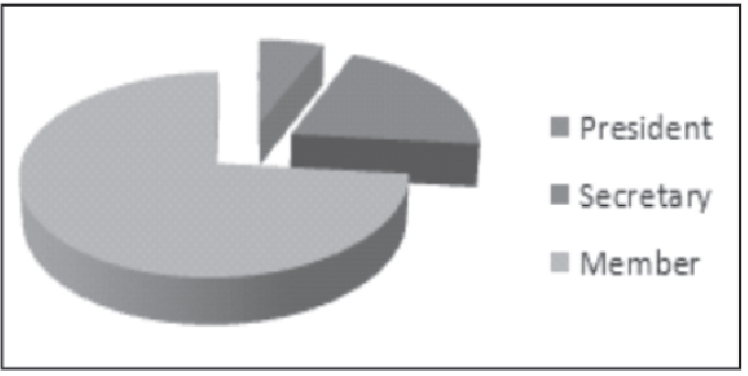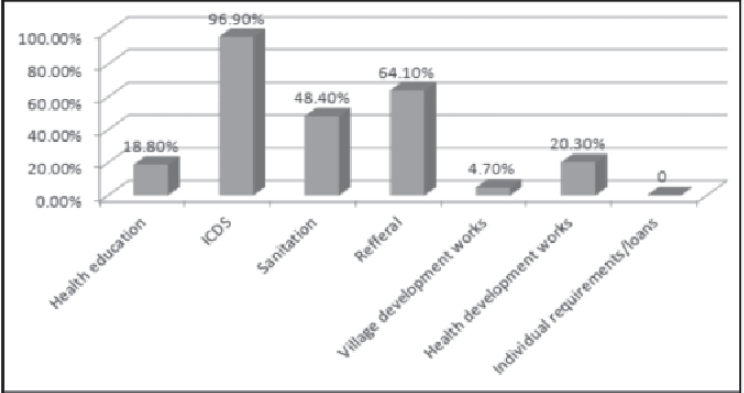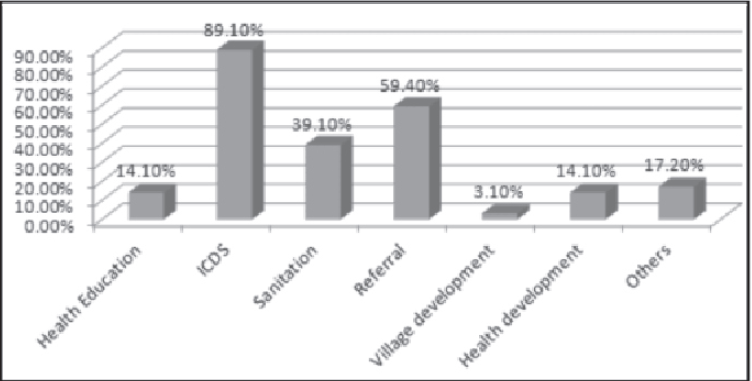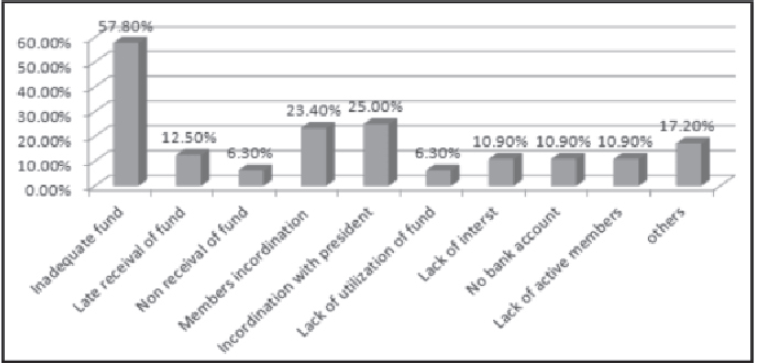Translate this page into:
Awareness regarding utilization of untied funds among the members of Village Health, Nutrition and Sanitation Committees (VHNSC) in selected villages of Wardha district
Corresponding contributor: Dr. Ishita Guha, District Family Welfare Officer IDFWO) & District Immunization Officer IDIO), West Tripura, Tripura Health Services, Agartala, Tripura (West). E-mail: ish.ta.agmc@yahoo.com
-
Received: ,
Accepted: ,
How to cite this article: Guha I, Raut AV, Pawar RD, Mehcndale AM, Garg BS. Awareness regarding utilization of untied funds among the members of Village Health, Nutrition and Sanitation Committees (VHNSC) in selected villages of Wardha district. J Comprehensive Health,2019;7(1):24-28.
Abstract
Background:
Village Health, Sanitation and Nutrition Committee (VHSNC); an initiative of National Rural Health Mission offers people opportunity to access the basic services: Health, Nutrition and Sanitation at the village level itself. To achieve the desired goal, VHNSC members must have a good knowledge regarding guidelines for utilization of funds. This study tried to assess the knowledge of the members of VHNSC regarding the allocation of fund and utilization of the untied fund as compared to the guidelines.
Methodology:
It is a cross sectional study carried out in 13 villages of Bhidi for a period of 2 months, August 2015 to September 2015. Convenient sampling wasfollowed. All members of VHNSCs who gave consent were included In the study. Data analysis was done in the Epi info version 7.
Results:
ln this present study majority of participants were Anganwadi workers (28.1%) followed by housewives (26.6%), with 85.9% members being female. 92.2% had some knowledge about utilization of fund and 70.3% had correct knowledge about the amount of fund received for VHNSC per annum. According to 71.9% fund was inadequate. 89.1% mentioned that fund utilization was mainly for nutrition purposes (89.1%), followed by referral to higher centre (59.4%), sanitation (39,1%). Main challenges faced were inadequate fund (57.8%), in coordination with President (25%), in coordination between members(23.4%), late receival of funds(12.5%), lack of interest of members(10.9%), no bank account (10.9%) etc. 84.4% members had no training.
Conclusion:
Study findings suggest that use of untied fund by VHNSCs is not as perthe guidelines mainly due to limited awareness of guidelines among VHNSC members. Quality training for VHNSC members is the need.
Keywords
Village Health
Nutrition and Sanitation Committee
untied fund
Introduction
One of the major initiatives under National Rural Health Mission is the Village Health, Sanitation and Nutrition Committee (VHSNC).(1) NRHM focuses on involving Panchayati Raj Institution members (PRI) in controlling and management of the public health services in order to achieve desired goals. Community participation is also given utmost importance to ensure service guarantee and the services availability. And this has been institutionalized by creating Village Health and Sanitation Committee at the village levels.(2)
As the name suggests this committee is expected to take collective action on issues related to health, and its social determinants In converging all the basic services related to Health, Nutrition, Sanitation at village levels.(1)
In VHNSC, the Sarpanch (elected head of village Panchayat) is president/Chairperson and AWW is the secretary mostly, other members are the ASHA, ANM, PRI members. The responsibility of the committee is to enhance people's participation in improving healthcare services in the rural areas by raising health awareness among the villagers, organizing village level meetings, sanitation drives and work on other identified health needs in the village with special focus on women and children.(3) The effectiveness of VHND mainly depends on the roles of the committee members, which can lead to bring drastic improvements in the way people perceive health and health care.(4) The NRHM has provided guidelines for allocation and utilization of funds and has provided 'untied fund'; an annual untied grant of 10,000 rupees per VHNSC.(5) Though guidelines have been implicated regarding the use of untied fund, various studies shows a deviation from the guideline.(6) Keshri VR et al. (2012) from his study findings suggested that the utilization of untied fund is not as per the prescribed guidelines mainly due to limited awareness among VHNSC members on these guidelines:' Dindod SM et al.(2013) study shows that the understanding about the guidelines among VHNSC members as well as presidents and secretaries is grossly inadequate,(8) Pandey A et al. (2012) mentioned in their study that though they found a high level of involvement at all levels among the respondents but there were gaps in understanding how untied money is received, tracked and monitored among the members.(5) A study in Karnataka (March 2012) showed poor participation at VHSC meetings which was the leading cause of difficulty in decision making for VHNSC.(2)
So to achieve the desired goal VHNSC members must have a good and in-depth knowledge regarding the allocation of grants per VHNSC per annum and guidelines for proper utilization of the funds in each section of health, sanitation, nutrition by the Government. VHNSC meetings should be carried out with specific objectives and active participation of functionaries which is mandatory to achieve the goals and aims of establishing VHNSC.(4) There is also need for training of VHNSC members and properly informing them about their collective roles and responsibilities towards VHNSC and continuous monitoring and support for VHNSC's active functioning.(7) In this background the present study was conducted to assess the awareness of the members of VHNSCs regarding current pattern of allocation and utilization of of untied funds.
Methodology:
Present cross sectional study was carried out during August 2015 to September 2015 was conducted in 13 villages under the field practice area of Rural Health Training Centre Bhidi which is part of Department of Community Medicine, Mahatma Gandhi Institute of Medical Sciences, Sevagram.
The members of VHNSCs in all these 13 villages who gave consent were included. Convenient sampling was followed. All the members of VHNSCs who gave consent were included in the study. A pre-designed semi-structured questionnaire was used to assess the knowledge regarding utilization of fund at VHNSC. Data entry and analysis was done in the Epi Info version 7. Frequencies and percentages were calculated to interpret the socio demographic characteristics, awareness of VHNSC members and knowledge and attitude regarding fund utilization pattern of VHNSC.
Results
A total of 64 members were interviewed and in depth interview were conducted with 4(6.3%) Presidents and 13(20.3%) Secretaries and rest members (73.7%) of VHNSC respectively. (Fig. 1) Majority of the participants were in the age group of 41 years to 60 years with 85.9% members being female. Most of the participants were AWWs (28.1%) followed by housewives (26.6%) and farmers (23.4%) and majority were educated up to middle school (48.4%) (Table 1).

- Designations of participants in VHNSC
| Socio Demographic Profile of the VHNSC members | Number (%) n= 64 |
|---|---|
| Age (in years) | |
| 21-41 | 27(42.2) |
| 41-61 | 32(50.0) |
| 61-81 | 5(7.8) |
| Sex | |
| Male | 9 (14.1) |
| Female | 55(85.9) |
| Caste | |
| ST | 10(15.6) |
| SC | 17(26.6) |
| Other backward class | 35(54.7) |
| Open/General | 1(1.6) |
| Others | 1(1.6) |
| Occupation | |
| Farming | 15(23.3) |
| Govt. service | 3(4.7) |
| House wife | 17(26.6) |
| ASHA | 5(7.8) |
| AWW | 18(28.1) |
| Business | 1(1.6) |
| Others | 5(7.8) |
| Education | |
| Primary school | 6(9.4) |
| Middle school | 31(48.4) |
| High school | 19(29.7) |
| Junior college | 2(3.1) |
| Graduate | 6(9.4) |
Table 2 shows that 85.9% members had awareness about meetings of VHNSC held in last 3 months and among them 70.3% had attended meetings at least once in last 3 months among them majority of participants attending meetings were AWWs (100.0%) and businessman (100%) and followed by 80% among ASHAs, 60% farmers, 58.8% house wives and very less only 33.3% among the government employees attended meetings. 71.9% members were aware about signatories responsible for maintenance of account of untied fund and 89.1% had knowledge regarding who withdraws the fund from the account.
| Number | (%) | |
|---|---|---|
| Awareness about meetings held in last 3 months | Yes | 55(85.9) |
| Do not Know | 9(14.1) | |
| Attendance in meeting at least once in last 3 months | Attended | 45(70.3) |
| Did not attend | 19(29.7) | |
| Knowledge about signatories of bank account | President | 6(9.4) |
| AWW | 7(10.9) | |
| ASHA+ President | 46(71.9) | |
| FHW | 3(4.7) | |
| Do not know | 2(3.1) | |
| Knowledge regarding who withdraws fund from the bank account | President | 4(6.3) |
| AWW | 57(89.1) | |
| Others/anv member | 2(3.1) | |
| Do not know | 1(1.6) |
Fig 2 shows majority of participants (96.9%) mentioned that fund is mostly used for ICDS, 64.1% mentioned fund utilized for referral/transport of diseased to nearby health care facility, 20.3% participants said fund is utilized for Anganwadi centre developmental works, 18.8% mentioned health education, and rest for village developmental works, no provision for individual requirements/loans.

- Distribution of participant's knowledge about areas where funds can be utilized by VHNSC
Regarding utilization of fund by VHNSC 92.2% had some knowledge and 70.3% had correct knowledge about the amount of fund receives for VHNSC per annum. It is seen that majority (92.3%) secretary i.e AWWs have knowledge regarding amount of fund received in VHNSC, 63.8% of members and 75% of presidents knows about correct amount of fund.
Most of the AWCs (40.4%) received 5001 to 7000 rupees per annum, 30.8% AWCs received 1001 to 5000 rupees, 23.1% receives 7001 to 10,000 rupees annually and 5.8% AWCs receives below 1000 rupees annually in last 3 years. Majority of participants (71.9%) said that fund amount was not adequate and 84% study population mentioned that fund should be between 11,000 to 15,000 rupees, 14% said it should be 16,000 to 20,000 rupees and 2% said above 20,000 rupees required per each VHNSC annually. Seen that (96.9%) had knowledgethat fund is beingallocated from government, only 3.1% participants had no idea regarding this. 87.5%study population mentioned that no additional funds are received and 7.8% said additional funds received from villagers or Gram Panchayat. 88.9% mentioned that decision making in the meetings were done by complete body of VHNSC, 9.5% said only President and 1.6% participants said decision Is taken by AWW alone. 73.4% participants mentioned according to them funds are utilized properly, 17.2% says fund utilization not done perfectly and 9.4% have no idea regarding utilization of fund by VHNSC. Majority of the members (84.4%) did not receive any training regarding VHNSC, only 15.6% had training that too only once till date.(Table 3)
| Knowledge | Number (%) |
|---|---|
| Knowledge about utilization of fund | 59(92.2) |
| Knowledge about amount of fund | 45(70.3) |
| Awareness about amount of fund received last year | |
| Up to 1000rs | 3(5.8) |
| 1001-5000rs | 16(30.8) |
| 5001-7000rs | 21(40.4) |
| 7001-10000rs | 12(23.1) |
| Total | 52(100.0) |
| Views regarding adequacy of fund amount | |
| Adequate | 10(15.6) |
| Inadequate | 46(71.9) |
| Do not know | 8(12.5) |
| Views regarding fund requirement | |
| 11,000-15,000/- | 42(84.0) |
| 16,000-20,000/- | 7(14.0) |
| >20,000/- | 1(2.0) |
| Knowledge regarding source of fund | |
| Government | 62(96.9) |
| Do not kn ow | 2(3.1) |
| Knowledge about receiving additional funds | |
| Receives | 5(7.8%) |
| Do not receive | 56(87.5) |
| Do not know | 3(4.7) |
| Decision makers in VHNSC meetings | |
| President | 6(9.5) |
| AWW | 9(1.6) |
| Complete body of VHNSC | 56(88.9) |
| Views regarding fund utilization done | |
| Perfectly done | 47(73.4) |
| Not done perfectly | 11(17.2) |
| Do now know | 6(9.4) |
| Views about fund utilization last year | |
| 80-100% | 46(71.9) |
| 60-80% | 1(1.6) |
| <40% | 3(4.7) |
| Do not kn ow | 14(21.9) |
| Training of VHNSC members | |
| Training received | 10(15.6) |
| No training received | 54(84.4) |
Fig 3 shows that in the VHNSC meetings fund utilization proposed in ICDS (89.1%), referral of patients to nearby health centres(59.4%), sanitation (39.1%), 14.1% in health education and health development or Anganwadi development works, 3.1% in village development and in others 17.2% (providing medicines, electric bills).

- Sectors in which fund utilization done as proposed in the meetings
Fig 4 shows that the problems faced in utilization of funds are Inadequate fund (57.8%), in coordination with President (25%), in coordination between members(23.4%), late receival of funds(12.5%), lack of interest(10.9%), no bank account (10.9%), lack of utilization of fund (6.3%) and others(17.2%).

- Distributions of problems faced by VHNSC members in utilization of property
Discussion
VHNSC fund is provided for centre/ Anganwadi centre specific, need based activities.(8)
In this study most of the participants (50%) were in the age group 41-60years, followed by 42.2% of 21-40 years, and majority among them (85.9%) were female(AWWs and house wives mostly); where as in the study of Keshri V R mean age of the participants was 37.7years with less female members(38.1%)(9) During in-depth interview participants told that the males are less interested or involved in VHNSC as they find difficulty in time adjustment after doing their business or farming.
Present study shows that 92.2% participants have some knowledge regarding utilization of fund by VHNSC. Among them 70.3% have correct knowledge regarding amount of fund i.e. 10,000/ year and 96.9% knew that the fund is provided by government; which is higher than the study of Dindod SM et al. (2013) which shows only 60% of participants had knowledge about correct amount of fund received and 82% had knowledge about receival of fund from Government(8). In the study of Pandey A et al. (2012) 51.3% were unaware of the amount of untied fund allocated which is much lessthanthisstudy.
85.9% reported that meetings were held in last 3 months and 70.3% attended meeting of VHNSC atleast once in last 3 months. Dindod SM et al. (2013) study reported only 70% participants told that meetings were held atleast once in last 3 months, whereas in the study of Pandey A et al. (2012) 85% had awareness about VHNSC meetings.(6) 71.9% study participants had correct knowledge about the signatories of bank account, which is higher than knowledge of participants in the study of Dindod SM et al. (2013) i.e 62%. But in the study of Tamilnadu 100% of participants had idea about the bank account signatories.(10) In the present study 89.1% participants have correct knowledge that AWW withdraws fund from the bank account, 88.9% told decisions in the VHNSC meetings are taken by complete body of the committee, which is much higher than Dindod SM et al. (2013) study 58% reported that decision making is done by consensus and in the study of Keshri VR only 8.3% members responded regarding it.
Inthe presentstudy 71.9% told that fund was inadequate and almost 12.5% did not answer, out of which majority told that it should be between 11,000/-15,000/- annually. In the study of Dindod SM et al. (2013) 20% members told that fund was inadequate and 25% members did not answer, of which majority told that 16,000/- to 20,000/- should be the adequate amount. Study conducted at Indore shows that almost 70% ANMs told that fund was inadequate and majority Le, 64% ANMs told that fund should be 16,000- 20,000 rupees(11) and study conducted at Uttarpradesh shows that 12.50% members told that fund provided is not enough and 85.9%members cannot say.(12)
The limitations of the study is that it was conducted on few participants and in a particular area so the results cannot be generalized.
Conclusion:
1. Study will help to assess the knowledge of the members aboutallocation and utilization of funds by VHNSC.
2. Need of quality training sessions of the core team and the front line workers and other functioningaspects of VNHSC can be assessed by the findings in the study.
3. Strategy for improvement in allocation and utilization of funds can be formulated based on the findings in the study.
Sources of support:
Nil
Conflict of interest:
Nil
References:
- [Online] (Developed during a consultative workshop January 2013) Available from: http://www.pbnrhm.org/docs/vhsnc_guidelines.pdf
- [Google Scholar]
- An Exploratory study of VHNSC and ARS functioning. Bangalore: Karnataka State Health System Resource Centre; 2012. Available from: https://www.academia.edu/3555266/An_exploratory _study_o_VHSC_functioning_Karnataka_March_20121
- [Google Scholar]
- Performance of village health, nutrition and sanitation committee: A qualitative study from rural Wardha, Maharastra. Available from: http://www.healthagenda.net/wp-content/uploads/2013/09/Performance-of-village-health-nutrition-and-sanitation-committee-A-qualitative-study-from-rural-Wardha-Maharashtral.pdf
- [Google Scholar]
- ScienceDirect Planningand preparation of VHND through convergence : Sharing experiences from Uttarakhand. 2014. CEGH Clin Epidemiol Glob Heal [Internet]. :1-7. Available from: http://dx.doi.org/10.1016/j.cegh.2014.11.001
- [Google Scholar]
- Guidelines for Village Health and Sanitation Committees, Sub Centres, PHCs and CHCs. Available from: http://mohfw.nic.in/NRHM/Documents/Guidelines_of _untied_funds_NRHM.pdf
- [Google Scholar]
- Tied, Untied fund? Assessment of Village Health Sanitation and Nutrition Committee, involvement in utilization of untied fund in Rajasthan. 2012. Available from: http://www.chsj.org/uploads
- [Google Scholar]
- Knowledge and utilisation regarding untied fund among village level committees in selected villages of Wardha, Maharashtra. 2012. BMC Proc [Internet], BioMed Central Ltd. 6:8. Available from: http://www.biomedcentral.eom/1753-6561/6/Sl/P8
- [CrossRef] [Google Scholar]
- Knowledge of Members Regarding Village Health and Sanitation Committees (VHSC) . 2013;2277:331-2.
- [CrossRef] [Google Scholar]
- Assessment of knowledge and utilization of untied fund provided to VHNSCs in selected villages of 5 sub-centre area of PHC, Anji in Wardha district. Available from: http://medind.nic.in/jaw/tll/il/jawtllilp30.pdf
- [Google Scholar]
- Assessment of village water and sanitation committees in district of Tamilnadu, India. Indian J Public Health. 2013;57:43-6.
- [CrossRef] [PubMed] [Google Scholar]
- A study on utilization of untied funds in sub-centres in Indore division under National Rural Health Mission. Available from: http://www.nihfw.org/pdf/RAHI-l%20Reports/lndore/lnner%20cover%20lndore.pdf
- [Google Scholar]
- Assessment of utilization of fund provided under the national rural health mission in Uttarpradesh. Indian J Public Health. 2009;55(3):137-42.
- [Google Scholar]






